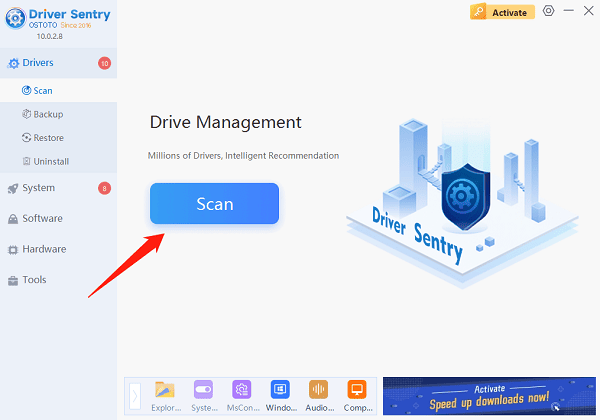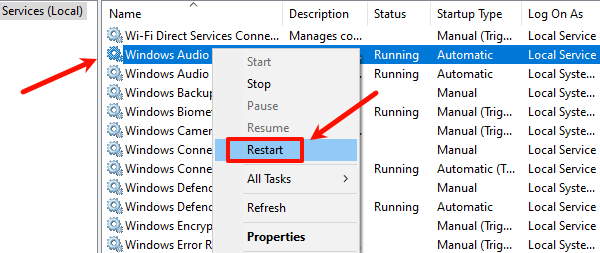If you've ever sat down at your computer, ready to watch a video, listen to music, or join a call, only to find that there's no sound, you know how frustrating it can be. The "no sound on computer" issue is a common headache for many users. But don't worry! In this blog, we'll walk you through six effective ways to solve this problem. And we'll also introduce you to a helpful tool that can make the process even easier.

How to Solve No Sound on Computer Problem
1. Update Your Audio Drivers with PcGoGo Driver Sentry
One of the most common reasons for having no sound on your computer is outdated or corrupted audio drivers. Audio drivers act as the link between your computer's operating system and the audio hardware. When they're not working correctly, you'll face audio issues.
That's where PcGoGo Driver Sentry comes in. It's a great tool that can automatically detect and update your drivers, saving you a ton of time and hassle. First, download the latest version of Driver Sentry. Once it's installed, open the software. You'll see a big "Scan" button-click it.
Driver Sentry will then start scanning your system. It's like a detective, searching for any missing or outdated drivers, especially those related to your audio. When the scan is done, look for the sound driver in the results list. It might be labeled with your audio hardware's name, like "Realtek Audio" or "High Definition Audio Device". Once you've found it, click "Upgrade".
After the upgrade is complete, restart your computer. This is important because it allows the new driver to be properly applied. Many times, simply updating the audio driver with PcGoGo Driver Sentry can fix the "no sound on computer" problem right away.

2. Check Your Hardware Connections
Before you start thinking it's a software problem, make sure to check your hardware connections. This is a simple step that can often solve the "no audio on computer" issue.
First, check the sound jack. If you're using headphones or speakers with a 3.5mm jack, make sure it's plugged into the correct port. Usually, the headphone or speaker port is green. If it's loose, try unplugging and plugging it back in firmly. For USB speakers or headphones, check that the USB cable is properly connected. If you're not sure if the USB port is working, try plugging the device into another USB port.
If you're using wireless devices like Bluetooth headphones, there are a few things to check. Make sure the headphones are paired successfully with your computer. You can usually check this in your computer's Bluetooth settings. Also, check the battery level of your wireless device. A low battery could be the reason why you're getting no sound.
It's also a good idea to test your speakers or headphones on another device. For example, if you have a smartphone, connect your headphones to it and see if you can hear sound. If they work on another device but not on your computer, the problem is likely with your computer's audio settings or drivers.
3. Adjust Your Volume Levels
Sometimes, the solution to the "no sound on computer" problem is as simple as checking your volume levels.

Start by looking at the system volume. On most computers, you can find the volume icon in the bottom-right corner of the taskbar. Click on it to open the volume slider. Make sure the volume isn't muted. If you see a red circle with a line through it, that means the sound is muted. Just click the icon to unmute it.
Next, check the application volume. Right-click the volume icon and select "Open Volume Mixer". Here, you'll see a list of applications and their volume levels. Make sure the volume sliders for all the applications you want to hear sound from are turned up. For example, if you're trying to watch a video on a browser, make sure the volume for that browser is not set to zero.
If you're using external speakers or headphones, don't forget to check the physical volume control knob on the device itself. Sometimes, it might have been accidentally turned down.
4. Restart Audio Services
Another way to fix the "no audio on pc" problem is to restart the audio services on your computer.
Press the Windows key and the "R" key at the same time. This will open the "Run" dialog box. Type "services.msc" and hit Enter. A window called "Services" will open.
In the services list, find "Windows Audio". Right-click on it and select "Restart". You should also check "Windows Audio Endpoint Builder" to make sure it's running. If it's not, right-click and select "Start".
To prevent these services from stopping unexpectedly in the future, you can set their "Startup Type" to "Automatic". To do this, right-click on each service, select "Properties", and change the "Startup Type" in the dropdown menu. Then click "OK" to save the changes.

5. Set the Correct Default Output Device
Your computer might be using the wrong audio device as the default, which can lead to the "no sound on computer" issue.
Right-click the volume icon in the taskbar and select "Open Sound Settings". In the "Output" section, look at the dropdown menu and choose the correct audio device. If you're not sure which one is the right one, you can try each one and see if you get sound.
Next, click "Manage Sound Devices" in the settings. Here, find your audio device and click "Set as Default". After that, click the "Test" button to check if there's sound output. This simple step can often solve the problem of no sound on your computer.
6. Run the Sound Troubleshooter
Windows has a built-in sound troubleshooter that can automatically detect and fix many common audio issues.
Press the Windows key and the "I" key at the same time to open the Settings menu. Navigate to "Update & Security", then click on "Troubleshoot". In the list of troubleshooters, find "Additional Troubleshooters".
Select "Playing Audio" and click "Run the Troubleshooter". Follow the on-screen instructions. The troubleshooter will scan your system for problems and try to fix them. It might ask you to perform some actions, like checking your hardware connections again or reinstalling your audio driver.
Conclusion
The "no sound on computer" problem can be a real pain, but with these six methods, you should be able to get your audio up and running again. Whether it's using PcGoGo Driver Sentry to update your drivers, checking your hardware connections, or running the sound troubleshooter, there's a solution for every situation. If you've tried all these steps and are still facing the "no audio on computer" or "no audio on pc" issue, it might be time to contact professional technical support. But in most cases, these simple fixes will do the trick. So, the next time you encounter no sound on your computer, don't panic. Just follow these steps, and you'll be listening to your favorite tunes or watching videos in no time.